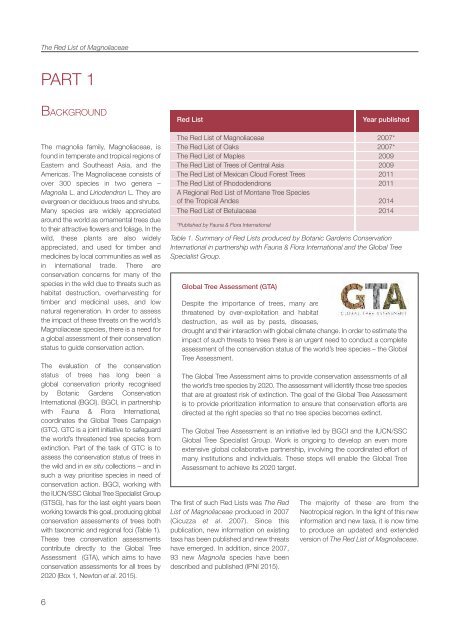Magnoliaceae
Magnoliaceae_RedList_2016_LowRes
Magnoliaceae_RedList_2016_LowRes
You also want an ePaper? Increase the reach of your titles
YUMPU automatically turns print PDFs into web optimized ePapers that Google loves.
The Red List of <strong>Magnoliaceae</strong><br />
PART 1<br />
BAckGROUnD<br />
Red List<br />
Year published<br />
The magnolia family, <strong>Magnoliaceae</strong>, is<br />
found in temperate and tropical regions of<br />
Eastern and Southeast Asia, and the<br />
Americas. The <strong>Magnoliaceae</strong> consists of<br />
over 300 species in two genera –<br />
Magnolia L. and Liriodendron L. They are<br />
evergreen or deciduous trees and shrubs.<br />
Many species are widely appreciated<br />
around the world as ornamental trees due<br />
to their attractive flowers and foliage. In the<br />
wild, these plants are also widely<br />
appreciated, and used for timber and<br />
medicines by local communities as well as<br />
in international trade. There are<br />
conservation concerns for many of the<br />
species in the wild due to threats such as<br />
habitat destruction, overharvesting for<br />
timber and medicinal uses, and low<br />
natural regeneration. In order to assess<br />
the impact of these threats on the world’s<br />
<strong>Magnoliaceae</strong> species, there is a need for<br />
a global assessment of their conservation<br />
status to guide conservation action.<br />
The evaluation of the conservation<br />
status of trees has long been a<br />
global conservation priority recognised<br />
by Botanic Gardens conservation<br />
International (BGcI). BGcI, in partnership<br />
with Fauna & Flora International,<br />
coordinates the Global Trees campaign<br />
(GTc). GTc is a joint initiative to safeguard<br />
the world’s threatened tree species from<br />
extinction. Part of the task of GTc is to<br />
assess the conservation status of trees in<br />
the wild and in ex situ collections – and in<br />
such a way prioritise species in need of<br />
conservation action. BGcI, working with<br />
the IUcn/SSc Global Tree Specialist Group<br />
(GTSG), has for the last eight years been<br />
working towards this goal, producing global<br />
conservation assessments of trees both<br />
with taxonomic and regional foci (Table 1).<br />
These tree conservation assessments<br />
contribute directly to the Global Tree<br />
Assessment (GTA), which aims to have<br />
conservation assessments for all trees by<br />
2020 (Box 1, newton et al. 2015).<br />
The Red List of <strong>Magnoliaceae</strong> 2007*<br />
The Red List of Oaks 2007*<br />
The Red List of Maples 2009<br />
The Red List of Trees of central Asia 2009<br />
The Red List of Mexican cloud Forest Trees 2011<br />
The Red List of Rhododendrons 2011<br />
A Regional Red List of Montane Tree Species<br />
of the Tropical Andes 2014<br />
The Red List of Betulaceae 2014<br />
*Published by Fauna & Flora International<br />
Table 1. Summary of Red Lists produced by Botanic Gardens Conservation<br />
International in partnership with Fauna & Flora International and the Global Tree<br />
Specialist Group.<br />
Global Tree Assessment (GTA)<br />
Despite the importance of trees, many are<br />
threatened by over-exploitation and habitat<br />
destruction, as well as by pests, diseases,<br />
drought and their interaction with global climate change. In order to estimate the<br />
impact of such threats to trees there is an urgent need to conduct a complete<br />
assessment of the conservation status of the world’s tree species – the Global<br />
Tree Assessment.<br />
The Global Tree Assessment aims to provide conservation assessments of all<br />
the world’s tree species by 2020. The assessment will identify those tree species<br />
that are at greatest risk of extinction. The goal of the Global Tree Assessment<br />
is to provide prioritization information to ensure that conservation efforts are<br />
directed at the right species so that no tree species becomes extinct.<br />
The Global Tree Assessment is an initiative led by BGcI and the IUcn/SSc<br />
Global Tree Specialist Group. Work is ongoing to develop an even more<br />
extensive global collaborative partnership, involving the coordinated effort of<br />
many institutions and individuals. These steps will enable the Global Tree<br />
Assessment to achieve its 2020 target.<br />
The first of such Red Lists was The Red<br />
List of <strong>Magnoliaceae</strong> produced in 2007<br />
(cicuzza et al. 2007). Since this<br />
publication, new information on existing<br />
taxa has been published and new threats<br />
have emerged. In addition, since 2007,<br />
93 new Magnolia species have been<br />
described and published (IPnI 2015).<br />
The majority of these are from the<br />
neotropical region. In the light of this new<br />
information and new taxa, it is now time<br />
to produce an updated and extended<br />
version of The Red List of <strong>Magnoliaceae</strong>.<br />
6


